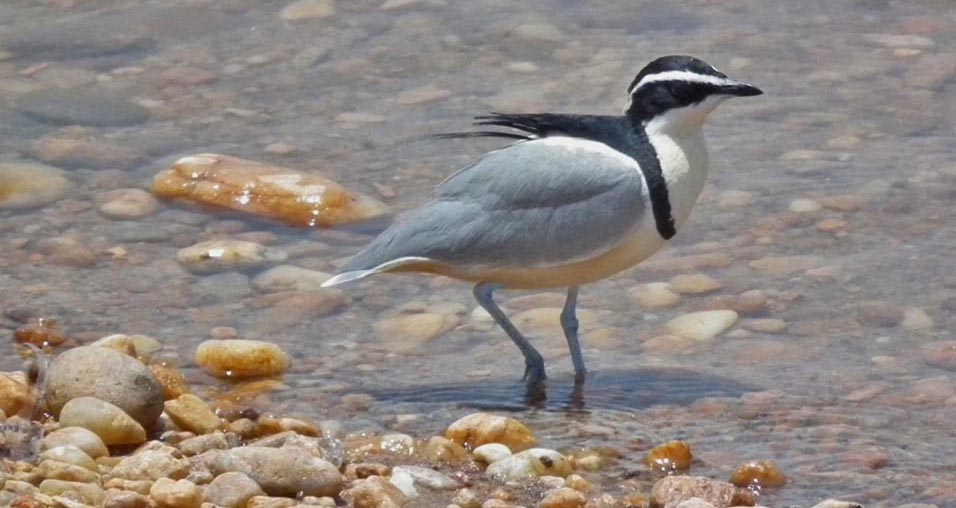
a web page by Don Roberson |
 |
EGYPTIAN PLOVER Pluvianidae |
|
 The
Egyptian Plover, aka "Crocodile Bird," is the sole member of a newly
erected family, the Pluvianidae. It is an enigmatic wader in the shape
of a courser that lives on riverine sandbanks in the hot, dry savannas
south of the Sahel in north Africa. It is a little known shorebird
whose original claim to fame was the now discredited story that it
picked the teeth of crocodiles! The
Egyptian Plover, aka "Crocodile Bird," is the sole member of a newly
erected family, the Pluvianidae. It is an enigmatic wader in the shape
of a courser that lives on riverine sandbanks in the hot, dry savannas
south of the Sahel in north Africa. It is a little known shorebird
whose original claim to fame was the now discredited story that it
picked the teeth of crocodiles! |
The range of the Egyptian Plover stretches from the Gambia (where Ed Harper took this lovely shot, above) all the way across Africa to Ethiopia, and thence sparing southward along the Nile to northern Uganda (where John Lofgreen photographed his bird, below), and along the Congo River to northern Angola. It formerly occurred north along the Nile to Egypt. |
 |
This species has been variously considered to be a plover, a courser, or an aberrant thick-knee. Study of morphological characters left its position uncertain. In recent decades, it has been traditionally placed within the family Glareolidae (Coursers and Pratincoles), and that is where it was placed in the Handbook of the World series (Maclean 1996). Some argued it was closer to the Burhinidae (Thick-knees) based on osteological characters (Strauch 1978, Chu 1995). Others, based on initial secondary means of studying DNA, suggested it might be in its own family (Sibley & Ahlquist 1990). Newer molecular evidence has helped to sort out what it is not. An analysis of mtDNA and nuclear DNA of 90 genera of shorebirds gave evidence that it was "apparently not a plover" (Baker et al. 2007). Fain & Houde (2007) reviewed mtDNA and nuclear DNA of 48 taxa, including some not previously studied, and found that Egyptian Plover "is distinct for the Glareolidae" and found no evidence of any particular "special relationship with stone-curlews [thick-knees]" either. The suggested that it is a basal taxa among the Charadriiformes (like thick-knees) and that the evidence "is consistent with the previous proposals that it merits family status as Pluvianidae." Hackett et al. (2008), working with even a larger set of taxa, agreed that "It is a separate lineage that is the outgroup to plovers, ibisbill, stilts and their allies." There the evidence current stands. There is still uncertainty about its exact relationships, but it appears distinct enough that the IOC now places Egyptian Plover in a monotypic family, tentatively named Pluvianidae. For the moment, so do I. The breeding biology of Egyptian Plover was the subject of a well-regarded monograph (Howell 1979). It buries its eggs in the sand during the day, wetting the sand with water, carried in its belly feathers after the manner of sandgrouse, to keep the eggs cool. The exposed tops of the eggs are incubated at night and, after the chicks hatch, chicks up to three weeks old are partially buried and wetted in this same way. This unusual behavior is shared only with some of the coursers. |
Meinertzhagen's veracity has been called into question numerous times since, and apparently no one else has documented this queer behavior. No plovers, Egyptian or otherwise, are inside the mouth of this gaping Nile Crocodile (right). Let us put it down as urban legend. |
Photos: The uppermost photo of two Egyptian Plover Pluvianus aegyptius on the West Volta River in northern Ghana on 15 Dec 2013. Ed Harper photographed the single Egyptian Plover Pluvianus aegyptius in the Gambia in Oct 2011. John Lofgreen photographed the next Egyptian Plover on the page at the Parra ferry crossing of the Nile River in Murchison Falls NP, Uganda, on 11 March 2011. The Nile Crocodile was along the Samburu River, Kenya, in Nov 1981. Bird photos © Don Roberson, © Ed Harper, and © John Lofgreen, used with permission; all rights reserved. Bibliographic note: Since only few recent authorities consider this taxa as deserving a full family, there is no "family book" per se. A decent introduction to this species, with some fine photos, is in Maclean (1996). Literature cited:
|
 The
myth about the Egyptian Plover as the "Crocodile Bird" has its origins
in the visit of Herodotus to Egypt in 459 BC, as summarized by Maclean
(1996): "His account of a small bird picking food from the teeth of a
gaping crocodile referred, it has been suggested, to the Egyptian
Plover. Whether or not this is so, the tale was further romanticized by
A. Brehm in the nineteenth century and R. Meinertzhagen in the
twentieth century, both of whom stated that they had personally seen
the Egyptian Plover picking the teeth of crocodiles on more than one
occasion."
The
myth about the Egyptian Plover as the "Crocodile Bird" has its origins
in the visit of Herodotus to Egypt in 459 BC, as summarized by Maclean
(1996): "His account of a small bird picking food from the teeth of a
gaping crocodile referred, it has been suggested, to the Egyptian
Plover. Whether or not this is so, the tale was further romanticized by
A. Brehm in the nineteenth century and R. Meinertzhagen in the
twentieth century, both of whom stated that they had personally seen
the Egyptian Plover picking the teeth of crocodiles on more than one
occasion."